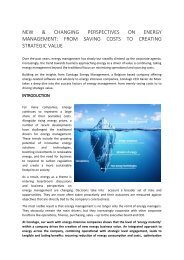Accurate Allocation of energy in production processes - the importance of using metamodels
Many companies struggle with correctly monitoring, allocating and distributing direct and indirect energy consumption over all internal and external customers, users or products. In this age of rising commodity costs and additional attention to sustainability, the advantages of adequately allocating energy are nonetheless substantial: 1. Real-time mapping of energy throughout process flows makes it easier to detect deviations in energy conversions during production processes, find the root causes and reduce losses. 2. Using exact and objective keys for allocating energy consumption speeds up periodic P&L and CSR reporting and makes for more accurate reports. 3. Continuous, real-time distribution of energy cost among users increases transparency and raises awareness with them. Although most companies already struggle with integrating correct data from metered equipment, this is only the first - albeit important - step. The crux is fully understanding the nature and efficiency of energy conversions processes; energy inflows and outflows to different customers; fixed and variable costs and corporate structures. By using metamodels - designed for and maintained by energy managers - all this information is added to the initial metered data and processed in such a way that any change from an energy point of view instantly leads to adjustments in the energy allocation. This white paper reviews emerging trends and challenges in energy allocation and examines the working and benefits of using specific metamodels at the level of energy management software.
Many companies struggle with correctly monitoring, allocating and distributing
direct and indirect energy consumption over all internal and external customers,
users or products. In this age of rising commodity costs and additional
attention to sustainability, the advantages of adequately allocating energy are
nonetheless substantial:
1. Real-time mapping of energy throughout process flows makes it easier
to detect deviations in energy conversions during production processes,
find the root causes and reduce losses.
2. Using exact and objective keys for allocating energy consumption
speeds up periodic P&L and CSR reporting and makes for more accurate
reports.
3. Continuous, real-time distribution of energy cost among users increases
transparency and raises awareness with them.
Although most companies already struggle with integrating correct data from
metered equipment, this is only the first - albeit important - step. The crux is
fully understanding the nature and efficiency of energy conversions processes;
energy inflows and outflows to different customers; fixed and variable costs
and corporate structures. By using metamodels - designed for and maintained
by energy managers - all this information is added to the initial metered data
and processed in such a way that any change from an energy point of view
instantly leads to adjustments in the energy allocation.
This white paper reviews emerging trends and challenges in energy allocation
and examines the working and benefits of using specific metamodels at the
level of energy management software.
Create successful ePaper yourself
Turn your PDF publications into a flip-book with our unique Google optimized e-Paper software.
Step 1: Distribution <strong>of</strong> acquired commodity costs to <strong>in</strong>ternal customers<br />
The acquired commodities like water, electricity and natural gas will have<br />
contracts and monthly <strong>in</strong>voices which specify both <strong>the</strong> costs as well as <strong>the</strong><br />
usage for each bill<strong>in</strong>g period. By divid<strong>in</strong>g <strong>the</strong> costs on <strong>the</strong> <strong>in</strong>voice by <strong>the</strong> usage<br />
for each commodity a commodity unit cost is calculated for each <strong>in</strong>voice period.<br />
For all commodity usages <strong>of</strong> acquired commodities <strong>the</strong> cost per period is<br />
calculated by multiply<strong>in</strong>g <strong>the</strong> usage by <strong>the</strong> unit cost.<br />
Step 2: Distribution <strong>of</strong> generated commodity costs to <strong>in</strong>ternal customers<br />
The generated commodities like electricity via w<strong>in</strong>d or solar, will have similar<br />
cost structures as <strong>the</strong> acquired commodity types. Depreciation costs, operat<strong>in</strong>g<br />
costs and ma<strong>in</strong>tenance costs which fall with<strong>in</strong> <strong>the</strong> current period are summed<br />
and divided by <strong>the</strong> gross <strong>production</strong> with<strong>in</strong> <strong>the</strong> same period. This yields an unit<br />
cost for <strong>the</strong> generated commodity types.<br />
For all commodity usages <strong>of</strong> generated commodities <strong>the</strong> cost per period is<br />
calculated by multiply<strong>in</strong>g <strong>the</strong> gross <strong>production</strong> by <strong>the</strong> unit cost.<br />
Step 3: Distribution <strong>of</strong> converted commodity costs to <strong>in</strong>ternal customers<br />
For <strong>the</strong> converted commodities, <strong>the</strong> cost structure is <strong>the</strong> same as for generated<br />
commodities: depreciation costs, operat<strong>in</strong>g costs and ma<strong>in</strong>tenance costs. The<br />
gross <strong>production</strong> is measured so <strong>the</strong> unit cost is as follows:<br />
For all commodity usages <strong>of</strong> converted commodities <strong>the</strong> cost per period is<br />
calculated by multiply<strong>in</strong>g <strong>the</strong> gross <strong>production</strong> by <strong>the</strong> unit cost.<br />
In addition to <strong>the</strong>se costs, <strong>the</strong> <strong>in</strong>put commodities for <strong>the</strong> conversion also br<strong>in</strong>g<br />
a cost. These will be calculated <strong>in</strong> <strong>the</strong> next step.<br />
Step 4: Translation <strong>of</strong> converted commodity usages to primary commodity<br />
usages<br />
Due to <strong>the</strong> <strong>importance</strong> <strong>of</strong> monitor<strong>in</strong>g <strong>the</strong> commodity conversion efficiencies,<br />
<strong>the</strong> <strong>in</strong>put commodity usages are measured directly and thus available for<br />
calculations.<br />
The costs associated with <strong>the</strong> <strong>in</strong>put commodity flows <strong>of</strong> <strong>the</strong> conversion nodes<br />
consist <strong>of</strong> <strong>the</strong> usage multiplied by <strong>the</strong> unit cost <strong>of</strong> <strong>the</strong> commodity.<br />
Depend<strong>in</strong>g on <strong>the</strong> source <strong>of</strong> <strong>the</strong> <strong>in</strong>put commodity flow, <strong>the</strong> unit cost is<br />
22




